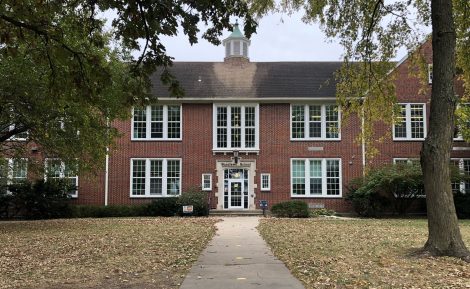Environmental advocate says road project in Douglas County’s next Capital Improvement Plan could have ‘cascading consequences’

photo by: Douglas County
A Douglas County map shows a proposed Wakarusa Drive extension, the white line running south from Kansas Highway 10, which would connect the roadway to County Route 458.
As the Douglas County Commission prepares to vote on its next five-year Capital Improvement Plan on Wednesday, local advocacy groups are voicing concerns about the potential environmental consequences of one of the road projects in the plan.
The Sustainability Action Network, the Lawrence Sunrise Movement and Lawrence Ecology Teams United in Sustainability are among the groups that have expressed their worries about the proposed extension of Wakarusa Drive south of Lawrence and over the Wakarusa River.
The project first surfaced as a combined effort between the city of Lawrence, the county and the Kansas Department of Transportation. The Lawrence City Commission pulled back from its plans to help pay for the road in late August, but the county did not. As the proposal currently stands, the county would be slated to contribute $9 million toward the project.
“City commissioners have told me — and planning commissioners, too — that the county has been thinking of doing this for some time and they’re most likely going to do it anyway,” said Michael Almon, a community organizer with the Sustainability Action Network. “No matter whether KDOT or the city is involved, the county still wants to do it. That is troubling.”
On Tuesday, Almon told the Journal-World that he thought the project directly conflicted with the joint city and county comprehensive plan, Plan 2040. He said Plan 2040 calls for prioritization of infill development — the development of unused land within the city limits — before expanding into rural areas outside the city limits through annexation.
Plan 2040 also separates the land in and around Lawrence into three tiers — Tier 1 is within the city limits, Tier 2 is the land near the city where future growth is anticipated, and Tier 3 includes land that isn’t expected to become part of Lawrence within the next 20 years. The land where this project would be built is in Tier 3, and Plan 2040 says Tier 3 land shouldn’t be annexed or developed unless that’s the only way to address a community need and provide benefits like creating permanent affordable housing or preserving environmentally sensitive areas.
“Sustainability Action’s position is, ‘OK, maybe this road is important and will be needed and will serve a function for access for that part of the county to get into the city in 20 years,'” Almon said. “Not now; maybe 20 years. Let’s go by the plan.”
If local governments don’t stick to their plan, Almon said, it could have “cascading consequences” on the ecology of the area around the Wakarusa River. The road could impact the unique plant life near the river, and it would go directly through prime farmland, Almon said. He said there would be a high potential for pollution from construction and ongoing traffic.
Almon said it’s hard to tell exactly how severe the environmental impact might be simply because the county hasn’t performed an environmental assessment yet. According to the county’s Public Works Department, that won’t need to happen until the initial design phase of the project.
“To me, (that means) we’re on course to do this, we’re moving ahead, and we’ll look at those environmental impacts only so far as we may mitigate for them,” Almon said. “But not that it’s going to mean that we won’t do the road.”
Almon said he was also aware of Indigenous people’s concerns about development in sensitive areas, such as the South Lawrence Trafficway’s expansion through what is now known as the Baker Wetlands.
County staff has already sought some public feedback on the proposed Wakarusa Drive extension, including by hosting a town hall meeting in late September. One of the main benefits of the project that county staff has touted would be an improvement in fire and medical response times by about three minutes. However, groups like Almon’s have proposed an alternative solution — building another fire and medical station in the area. Almon said the improvement in emergency response times wouldn’t be worth the financial and environmental costs.
“Why do we want to spend $9 million and compromise and degrade our ecosystems and fly in the face of Native Americans once again for two or three minutes?” Almon said. “Why? It’s absurd.”
Because of water damage in the Douglas County Courthouse’s commission meeting room, Wednesday’s business meeting will instead take place in the Division 2 courtroom at the Judicial and Law Enforcement Center, 111 E. 11th St., at 5:30 p.m. Normal Judicial and Law Enforcement Center security protocols will be followed, and members of the public will be screened at a checkpoint upon entry to the building. The meeting will also be available by Zoom. For meeting information, visit the county’s website.







